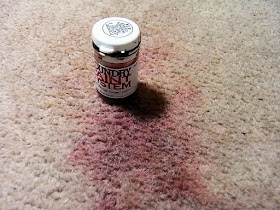I felt suitably inspired last Sunday to finally have a bash at a wargame with the Hinton Hunts. It was a small affair using two terrain tiles to produce a battlefield just 2’ by 4’ and I played solo using my own rules Muskets & Marshals. The game took about two hours to play, lasted only five turns and was surprisingly good fun. This is what happened.
The Duke of Wellington (with his ADC Lord Hill) had deployed the Allied force in line to defend a vital crossroads. On the left were the Naval Battalion commanded by Sir Thomas Picton (resplendent in red coat and top hat) and on the right were the Silesian Landwehr under the watchful eye of old Marshal Vorwarts. Ponsonby’s Union brigade supported the Landwehr while Mercer’s horse artillery was placed across the main road between the two infantry battalions.

The Allied army deployed in line ready to defend the crossroads.
A few hundred yards to the east the Emperor (with his ADC Marshal Bernadotte) was preparing his force for the attack. From left to right deployed in column were the 4th Swiss (General Aldercreutz), the 45th Ligne (Marshall Lannes) and the Nassau grenadiers (General Klingspor). On the extreme right flank were the Imperial Guard horse artillery and to the rear of the infantry line was General D’Hilliers with the heavy cavalry. To the front, deployed in skirmish formation, were the elite 10th Legere in their lovely furry hats.
 The French army getting ready to advance.
The French army getting ready to advance.
Happy that all was now ready the Emperor signalled the artillery to open fire at long range on the Naval battalion, which they duly fired upon and failed to hit. Captain Mercer, not waiting for the Duke’s command, gave the retaliatory order “open fire!” to his battery sergeant and the six-pounder’s let rip with a roar.
 Mercer gives the order “open fire!”
Mercer gives the order “open fire!”
The first shot from Mercer’s guns flew across the field and knocked brave Marshal Lannes from his horse before bouncing through the ranks of the 45th Ligne where it claimed a further casualty. The Duke was not impressed “The commanders of armies have something better to do than fire upon one another.” he exclaimed to Lord Hill. “Yes your grace.” Hill replied, “but it was a damn good shot!”

Marshal Lannes becomes a “fallen leader”.
The Emperor, angered by the turn of events turned to Bernadotte “Mon dieu! These English are not gentlemen at all. Send forward the 10th Legere, we will show them the way we French play wargames!”
 The 10th Legere advance on the Allied line.
The 10th Legere advance on the Allied line.
The French Light infantry moved up to effective musket range and started to pepper the Allied line with musketry (
skirmishers may move up to half a move and fire with full effect). The Landwehr soon lost one man to their fire but then the Naval Battalion suffered a greater blow as the skirmish group to their front rolled 4 sixes!
 “We will show them the way we French play wargames!”
“We will show them the way we French play wargames!”
The Naval battalion were visibly shaken by the ordeal as Picton rode up and down the line trying to restore order in their ranks.
 Picton steadies the Naval Battalion.
Picton steadies the Naval Battalion.
At his command post near the church Wellington looked on “Hot work Lord Hill, what time is it now?” “Just past turn two your grace.” Replied Hill. “I think I may ride forward to give Picton a hand (
and an extra plus 1 on morale), I’m sure Blucher will hold on the right with the support of Ponsonby’s cavalry.”
To be continued…
 Following the Battle of the Crossroads I have had a final tweak of my house rules Muskets & Marshals. I say ‘final’ tweak even though experience has shown me that there is actually no such thing because tinkering with rules is as much a symptom of my borderline OCD as the desire to keep re-basing my model soldiers is.
Following the Battle of the Crossroads I have had a final tweak of my house rules Muskets & Marshals. I say ‘final’ tweak even though experience has shown me that there is actually no such thing because tinkering with rules is as much a symptom of my borderline OCD as the desire to keep re-basing my model soldiers is.






















